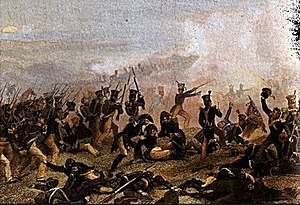| Battle of Lundy's Lane | |||||||
|---|---|---|---|---|---|---|---|
| Part of the War of 1812 | |||||||
 Battle of Lundy's Lane, Alonzo Chappel | |||||||
| |||||||
| Belligerents | |||||||
|
Preview warning: Page using Template:Flagcountry with unknown parameter "3 = 1801" |
| ||||||
| Commanders and leaders | |||||||
|
|
| ||||||
| Strength | |||||||
| 3,500[1] | 2,500[2] | ||||||
| Casualties and losses | |||||||
|
84 killed 559 wounded 169 captured 55 missing[3][4] | |||||||
| Official name | Battle of Lundy's Lane National Historic Site of Canada | ||||||
| Designated | 1937 | ||||||
The Battle of Lundy's Lane, also known as the Battle of Niagara or contemporarily as the Battle of Bridgewater,[8] was fought on 25 July 1814, during the War of 1812, between an invading American army and a British and Canadian army near present-day Niagara Falls, Ontario. It was one of the bloodiest battles of the war,[9] and one of the deadliest battles fought in Canada,[10] with approximately 1,720 casualties including 258 killed.
The engagement was marked by intense musketry at close range and instances of friendly fire on both sides amidst the smoke and confusion, which caused several units to break entirely.[11] The two armies fought each other to a stalemate; neither side held firm control of the field following the engagement. However, the casualties suffered by the Americans precipitated their withdrawal, and the British held the strategic initiative.
- ^ Graves (1997), pp. 261–262.
- ^ Graves (1997), pp. 257–258.
- ^ Graves (1993), p. 173.
- ^ Graves (1993), p. 174.
- ^ Wood, p. 164.
- ^ Graves (1993), p. 175.
- ^ Whitehorne, pp. 149–150.
- ^ The War of 1812 Archived 14 August 2010 at the Wayback Machine
- ^ Heidler (2004), p. 161.
- ^ Belanger (2009), p. 72.
- ^ Elting (1995), p. 194.